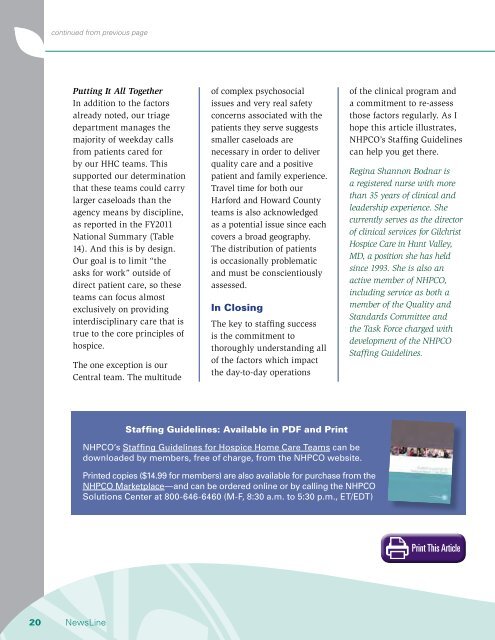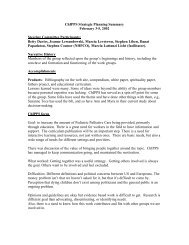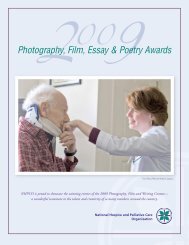PDF version - National Hospice and Palliative Care Organization
PDF version - National Hospice and Palliative Care Organization
PDF version - National Hospice and Palliative Care Organization
You also want an ePaper? Increase the reach of your titles
YUMPU automatically turns print PDFs into web optimized ePapers that Google loves.
continued from previous page<br />
Putting It All Together<br />
In addition to the factors<br />
already noted, our triage<br />
department manages the<br />
majority of weekday calls<br />
from patients cared for<br />
by our HHC teams. This<br />
supported our determination<br />
that these teams could carry<br />
larger caseloads than the<br />
agency means by discipline,<br />
as reported in the FY2011<br />
<strong>National</strong> Summary (Table<br />
14). And this is by design.<br />
Our goal is to limit “the<br />
asks for work” outside of<br />
direct patient care, so these<br />
teams can focus almost<br />
exclusively on providing<br />
interdisciplinary care that is<br />
true to the core principles of<br />
hospice.<br />
The one exception is our<br />
Central team. The multitude<br />
of complex psychosocial<br />
issues <strong>and</strong> very real safety<br />
concerns associated with the<br />
patients they serve suggests<br />
smaller caseloads are<br />
necessary in order to deliver<br />
quality care <strong>and</strong> a positive<br />
patient <strong>and</strong> family experience.<br />
Travel time for both our<br />
Harford <strong>and</strong> Howard County<br />
teams is also acknowledged<br />
as a potential issue since each<br />
covers a broad geography.<br />
The distribution of patients<br />
is occasionally problematic<br />
<strong>and</strong> must be conscientiously<br />
assessed.<br />
In Closing<br />
The key to staffing success<br />
is the commitment to<br />
thoroughly underst<strong>and</strong>ing all<br />
of the factors which impact<br />
the day-to-day operations<br />
of the clinical program <strong>and</strong><br />
a commitment to re-assess<br />
those factors regularly. As I<br />
hope this article illustrates,<br />
NHPCO’s Staffing Guidelines<br />
can help you get there.<br />
Regina Shannon Bodnar is<br />
a registered nurse with more<br />
than 35 years of clinical <strong>and</strong><br />
leadership experience. She<br />
currently serves as the director<br />
of clinical services for Gilchrist<br />
<strong>Hospice</strong> <strong>Care</strong> in Hunt Valley,<br />
MD, a position she has held<br />
since 1993. She is also an<br />
active member of NHPCO,<br />
including service as both a<br />
member of the Quality <strong>and</strong><br />
St<strong>and</strong>ards Committee <strong>and</strong><br />
the Task Force charged with<br />
development of the NHPCO<br />
Staffing Guidelines.<br />
Staffing Guidelines: Available in <strong>PDF</strong> <strong>and</strong> Print<br />
NHPCO’s Staffing Guidelines for <strong>Hospice</strong> Home <strong>Care</strong> Teams can be<br />
downloaded by members, free of charge, from the NHPCO website.<br />
Printed copies ($14.99 for members) are also available for purchase from the<br />
NHPCO Marketplace—<strong>and</strong> can be ordered online or by calling the NHPCO<br />
Solutions Center at 800-646-6460 (M-F, 8:30 a.m. to 5:30 p.m., ET/EDT)<br />
20 NewsLine









